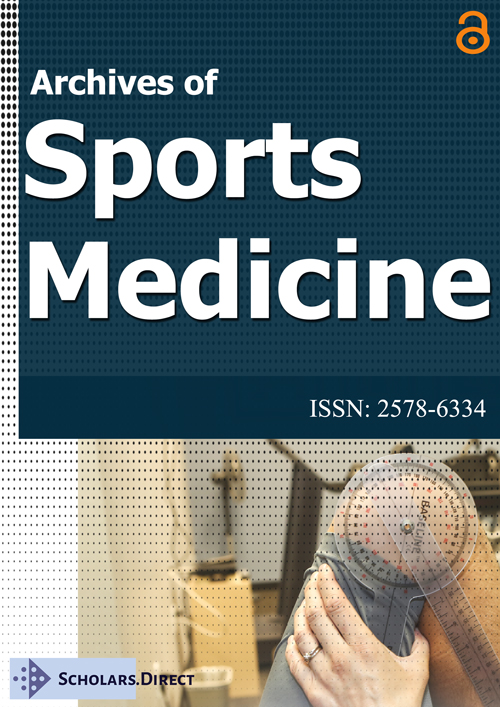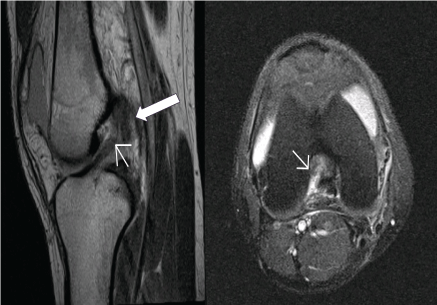Traumatic Anterior Cruciate Ligament (ACL) Rupture from Muaythai Kickboxing: A Case Report
Abstract
A 30-year-old female Muaythai boxer presented with a 48 hour history of instability and acute pain in her right knee after hearing a "pop". There was no prior history of trauma. On the previous day, she had been training in Muaythai, specifically, clinching and knee-sparring, a common activity as part of fighter training. X-ray showed no acute fracture and only small suprapatellar joint effusion. Initial clinical examination was performed by a licensed physical therapist/certified athletic trainer with board specialties in orthopedics and sports. This examination noted an asymmetrical gait pattern with hesitation to flex the knee in weight bearing (quadriceps avoidance), with associated feeling of apprehension. The resulting clinical impression was patellar subluxation and possible low-grade ACL tear. Subsequent MRI revealed a high-grade partial to complete tear of the ACL involving the near entirety of the anteromedial bundle and to a slightly lesser extent the anterolateral bundle. Additional impressions included a grade 2 sprain of the superficial MCL; a grade 2 sprain of the medial head of the gastrocnemius; a grade 1 sprain of the lateral head of the gastrocnemius. Finally, a complex tear involving the posterior root of the lateral meniscus. We suggest that the cause of the ACL rupture and additional sprains was direct pressure on right patellar joint pinning the leg and then rotating the upper body over this fulcrum while training in the Muaythai clinch.
Introduction
Muaythai, often translated into English as Thai boxing, is the national sport of Thailand and is a martial art in which fighters use several parts of the body for offensive and defensive purposes. Fists, elbows, knees, and feet are used to strike the opponent or defend from the attacks of their opponent. As this is primarily a striking martial art, blunt trauma of the musculoskeletal system are the most common sources of morbidity among Muaythai boxers. Associated injuries include contusions, lacerations, sprains, strains and fractures. The lower extremities are at particular risk for injury as they are used extensively to both defend against and deliver full-force attacks [1-6]. A unique aspect of Muaythai involves upright clinching or grappling, with the aim of off-balancing an opponent with a throwing action (usually they attack lower extremities) and immediately following with a strong striking technique. Because this is a very effective way to persuade judges to give a better score, fighters often specifically train in the clinch to develop this skillset [7]. Given the physiologic demands of Muaythai, couple with rapid limb movements, the risk of acute injury to the knee, shoulder and ankle is another potential outcome [8-10].
Case Presentation
A 30-year-old right hand dominant female Muaythai fighter presented with a 48-hour history of an acute right knee pain after hearing an audible "pop" when training. On the previous day, she had been training, particularly spending several round clinching and knee-sparring. During this exercise she was pitched to the canvas and felt pain in her right patellar region. The following morning she had pain in her patellar region and she was unable to extend fully or bear weight when walking. There was no previous history of knee injury and no evidence of degenerative joint disease.
Initial X-ray showed no acute fractures (Figure 1). The medial and lateral tibiofemoral joint compartments were preserved. Joint alignment was anatomic. There was a small suprapatellar joint effusion.
Initial clinical examination was performed by a licensed physical therapist/certified athletic trainer with board specialties in orthopedics and sports. Findings included an asymmetrical gait pattern with hesitation to flex the knee in weight bearing (quadriceps avoidance), with associated feeling of apprehension. Minor swelling (grade 1 stroke test for effusion). No palpable pain at the following anatomical landmarks: Medial joint line; Lateral joint line; Patellar tendon; Popliteal fossa; Distal Iliotibial Band (ITB) insertion. Valgus and varus stress tests were notes as symmetrical with no pain. Anterior drawer and Lachman's test for anterior translation were noted as grade 1 (up to 5 mm tibial-femoral translation), with no pain, and a light apprehension. Pivot-shift test was difficult secondary to patient guarding. No sag sign or increased posterior tibial translation on the involved sign for Posterior Cruciate Ligament (PCL) involvement. McMurray's and Apley's test for meniscal involvement were negative. Thessaly's test for meniscal involvement could not be performed secondary to apprehension in weight bearing. Patient demonstrated a positive patellar apprehension test (no pain). Involved knee Passive Range of Motion (PROM): 2-0-130 (minor soreness at end-range flexion). Manual muscle testing showed involved side findings of quadriceps 4/5 (no pain), gluteal medius 4/5, all other muscles groups symmetrical in testing. The clinical impression was a possible low-grade ACL tear with patellar subluxation.
MRI examination yielded a moderate-sized joint effusion without intra-articular loose bodies. There was a grade 2 sprain of the medial head of the gastrocnemius and grade 1 sprain of the lateral head of the gastrocnemius. The neurovascular bundle was normal. The overall impression was a high-grade partial to complete tear of the ACL involving the near entirety of the anteromedial bundle and to a slightly lesser extent the anterolateral bundle. Additional impressions included a grade 2 sprain of the superficial MCL; a grade 2 sprain of the medial head of the gastrocnemius; a grade 1 sprain of the lateral head of the gastrocnemius. Finally, a complex tear involving the posterior root of the lateral meniscus, with blunting of the free edge of the anterior body root junction to the posterior root junction of the medial meniscus. Surgical treatment was recommended (Figure 2).
Discussion
This unusual injury was probably a result of the grappling and attempted throw from her opponent, which were part of the fighter training routine of this patient. The mechanism of injury was likely the rotation about a planted foot and contact with the opponent's left leg acting as a fulcrum when executing the throwing action. The opponent's immovable leg acted as an external object increasing the forces. This sudden change in direction and pivot against a locked knee, while simultaneously twisting while the patient's foot was firmly planted on the ground is one of the main causes of Anterior Cruciate Ligament (ACL) injuries in female athletes [11].
Specific Muaythai activities like clinch and knee-sparring often demand unusual postures or high pressure to structures not normally designed for such biomechanical stress. This case identified an unusual presentation of rupture of the ACL, not from the striking component of Muaythai, which is plausible, but from a sublevel of activity involving stand up grappling. As women are up to 8 times more likely than their male counterparts to injure their ACL in the same sport [12], the distorted positions the lower limbs can be forcibly placed in [11], prevention efforts should be to develop explosiveness and proprioceptive awareness. Addition educational efforts should target Muaythai trainers, coaches, and participants. Should you engage in Muaythai clinch and knee-sparring, exercise caution with the ligaments around the knee as abnormal postures are being employed during this activity.
Acknowledgement
The authors would like to thank Dr. Kelli Lombardi for her assistance in providing the images and figures.
Author's Contribution
SS and KE contributed to patient management. SS was the major contributor in writing the manuscript. KE critically reviewed the manuscript. All authors read and approved the final manuscript.
Financial Disclosure
The authors have no financial relationships relevant to this article to disclose.
Funding/Support
No external funding.
References
- Gartland S, Malik MH, Lovell ME (2001) Injury and injury rates in Muay Thai kick boxing. Br J Sports Med 35: 308-313.
- Gartland S, Malik MH, Lovell M (2005) A prospective study of injuries sustained during competitive Muay Thai kickboxing. Clin J Sport Med 15: 34-36.
- Strotmeyer S Jr, Coben JH, Fabio A, et al. (2016) Epidemiology of Muay Thai fight-related injuries. Inj Epidemiol 3: 30.
- Ahmad R, Mohamad N, Silva TL, et al. (2010) Tomoi (Muay Thai Kickboxing) death: A lesson learned. International Journal of Case Reports and Images 1: 10-14.
- Shirani G, Motamedi MH, Ashuri A, et al. (2010) Prevalence and patterns of combat sport related maxillofacial injuries. J Emerg Trauma Shock 3: 314-317.
- Buse GJ, Wood RM (2006) Safety profile of amateur kickboxing among military and civilian competitors. Mil Med 171: 443-447.
- Myers TD, Balmer NJ, Nevill AM, et al. (2006) Evidence of nationalistic bias in MuayThai. J Sports Sci Med 5: 21-27.
- Crisafulli A, Vitelli S, Cappai I, et al. (2009) Physiological responses and energy cost during a simulation of a Muay Thai boxing match. Appl Physiol Nutr Metab 34: 143-150.
- Cappai I, Pierantozzi E, Tam E, et al. (2012) Physiological responses and match analysis of Muay Thai fighting. International Journal of Performance Analysis in Sport 12: 507-516.
- Turner AN (2009) Strength and conditioning for Muay Thai athletes. Strength and Conditioning Journal 31: 78-92.
- Jarrett GJ, Orwin JF, Dick RW (1998) Injuries in collegiate wrestling. Am J Sports Med 26: 674-680.
- Arendt EA (2007) Musculoskeletal injuries of the knee: Are females at greater risk? Minn Med 90: 38-40.
Corresponding Author
Stephen Strotmeyer, PhD, MPH, Division of General Surgery and Trauma, Department of Surgery, University of Pittsburgh Medical Center, Pittsburgh, Pennsylvania; Children's Hospital of Pittsburgh of UPMC, 7th Floor, Faculty Pavilion, One Children's Hospital Drive, 4401 Penn Ave, Pittsburgh, PA 15224, USA.
Copyright
© 2017 Strotmeyer SJ, et al. This is an open-access article distributed under the terms of the Creative Commons Attribution License, which permits unrestricted use, distribution, and reproduction in any medium, provided the original author and source are credited.






